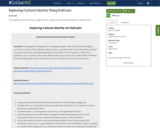
This assignment was made for an English II class. It uses various PodCasts epsidoes to explore culture.
- Subject:
- Speaking and Listening
- Material Type:
- Activity/Lab
- Author:
- JULIE SALYARDS
- Date Added:
- 06/15/2021

This assignment was made for an English II class. It uses various PodCasts epsidoes to explore culture.
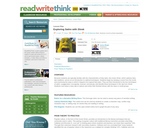
This resource provides a lesson designed to help students understand the use of satire and the myriad technicques that authors may use to add it to their writing. Students use the film Shrek to examine the four techniques of exaggeration, incongruity, reversal and parody. Students prove their understanding by using satire to rewrite a fairly tale.
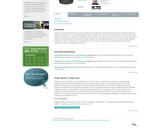
Students are introduced to the idea of "The Simpsons" as satire by comparing what they did on a typical day to the things the Simpsons do in the opening sequence of the show. Students use the character profiles on the Simpsons website to analyze six characters, identifying satirical details that reveal the comment/criticism being made about society through the characters. Finally, students use a graphic organizer to record and analyze specific examples of satire as they watch a full episode.

In this lesson on Family Ties from Teaching Tolerance, students will critically evaluate media messages on the issue of immigration and families, illustrate a narrative, and prepare and conduct an interview and debate on how undocumented status affects the day-to-day lives of immigrant families, particularly women.
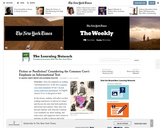
Students will reflect on their reading experiences in and out of school and discuss the roles that both fiction and non-fiction played. Next, they will become familiar with what the Commmon Core Standards say about reading, and what critics and supporters have written in reaction. Ultimately, students will write about the question, "What should students read?"
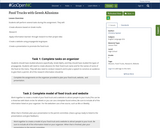
Students will perform several tasks during this assignment. They will:-Create allusions based on Greek muths-Research -Apply information learned through research to their project idea-Create a website using propaganda tecgniques-Create a presentation to promote the food truck
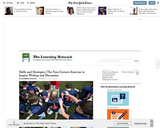
Students move around the room to show their level of agreement or disagreement with a statement on a particular issue. Includes prompts and resources for discussion and debate.

In this lesson, students will learn about the 1965 marches from Selma to Montgomery during the Civil Rights Movement. They will examine the Voting Rights of 1965 and watch clips from the movie Selma. Most importantly, students will think critically about sources of information.
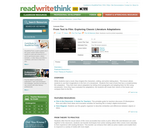
This lesson is designed to accompany a reading of a text that has a film version. Students will create visions of a given text and compare them to the film version.
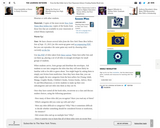
Students will go "inside" the NY Times Best Sellers List to explore recent best sellers across categories, then use those lists as models to create their own in categories of their choosing. They will write one-sentence summaries for each book on their lists, then analyze and explain their choices by writing "Inside the List" articles. Ultimately, students will answer the question, "What do best-seller lists tell us about our culture?"
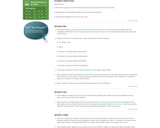
The graphic novel Persepolis is set in Iran during the Islamic Revolution. Most students are unaware of the changes associated with the events during that time, but the repercussions of the revolution are still being felt throughout the world. In this lesson, students work in small groups to research a specific topic related to Iran, using a WebQuest to focus their research on relevant and reliable information. After the research is complete, students present their information to the class through a technology-enhanced presentation.

In this lesson, students will discuss and write messages about how it feels to be grouped or identified by gender. Then, students will work in groups to record and discuss messages shared with others in the class.

This video from Shakespeare Uncovered explores the origins, unique characteristics and challenges presented by the 17th century Globe Theatre. Students will take a glimpse into the world of Elizabethan theater by watching actors perform scenes from Shakespeare’s plays on the stage of Shakespeare’s Globe, a modern-day replica of the Globe Theatre located one hundred feet from the original.

This lesson alerts students to the fallacies that surround them every day. In this lesson, students deconstruct fallacious images and messages in advertisements and demonstrate their understanding of the fallacies through multimedia presentations.
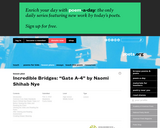
In this lesson, students will explore poetry both visually--through a provided video--and orally--through reading the poem "Gate A-4" by Naomi Shihab Nye aloud. Pre-reading/viewing activity will utilize small group tableaux as a way of physically visualizing issues within the poem. Post reading/viewing tableaux will reflect new ideas based on learning, and an optional essay on community furthers student exploration of empathy.

In this lesson, students will listen to a Native American song (included), view a video (included), and read Joy Harjo's poem, "Remember" in order to evaluate and compare visually, quantitatively, and orally the structures and content of a spoken and written poem to those in a Native American song. Activities include small group work and class discussion.
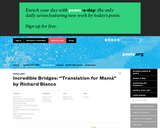
In this lesson, students will explore poetry both visually--through a provided video--and orally--through reading the poem "Translation for Mama" aloud. Pre-reading/viewing activity will utilize short writing and discussion as a class. Post reading activities involve writing poetry modeled on the poem.

In this lesson, students will understand the economic, environmental, societal effects that various inventions had upon the population by researching key figures, events, documents, maps, photos, videos, and recordings. This project-based learning lesson plan attempts to develop collaborative and communicative skills as well as higher order thinking by having students work together on teams to research the industrial revolution using primary and secondary sources. They will then create a product or presentation that answers the driving question and present their work to the class.

Students begin by evaluating the universal theme of betrayal from multiple perspectives. After reading time period scenarios as well as reflecting on personal experiences, students use critical thinking skills to explore and identify interventions for each betrayal scenario, including personal examples. Students then research Roman history as they write down thier own critical perspective of a scenario depicting plausible scenes from Roman times. As the culminating project and assessment, students will create comic strips with the Interactive Comic Creator
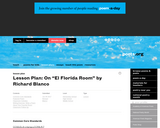
In this lesson, students will work to investigate photographs, explore their own memories and experiences, and the poem, "El Florida Room."